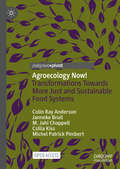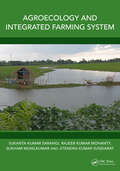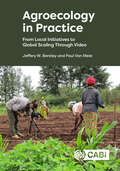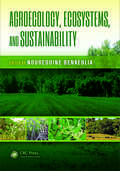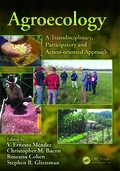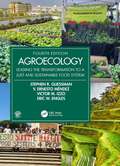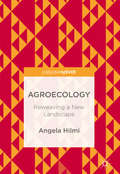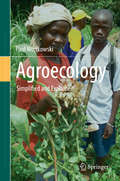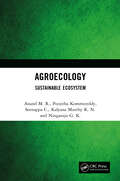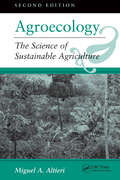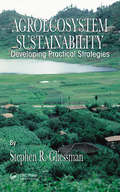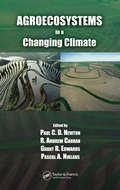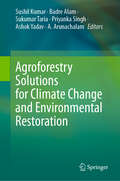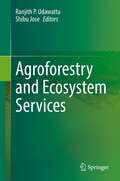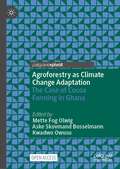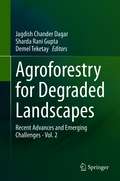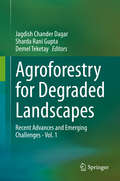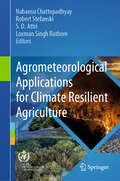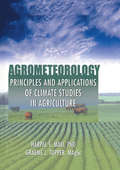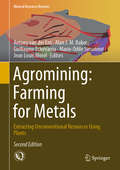- Table View
- List View
Agroecology Now!: Transformations Towards More Just and Sustainable Food Systems
by M. Jahi Chappell Colin Ray Anderson Janneke Bruil Csilla Kiss Michel Patrick PimbertThis open access book develops a framework for advancing agroecology transformations focusing on power, politics and governance. It explores the potential of agroecology as a sustainable and socially just alternative to today’s dominant food regime. Agroecology is an ecological approach to farming that addresses climate change and biodiversity loss while contributing to the Sustainable Development Goals. Agroecology transformations represent a challenge to the power of corporations in controlling food system and a rejection of the industrial food systems that are at the root of many social and ecological ills. In this book the authors analyse the conditions that enable and disable agroecology’s potential and present six ‘domains of transformation’ where it comes into conflict with the dominant food system. They argue that food sovereignty, community-self organization and a shift to bottom-up governance are critical for the transformation to a socially just and ecologically viable food system. This book will be a valuable resource to researchers, students, policy makers and professionals across multidisciplinary areas including in the fields of food politics, international development, sustainability and resilience.
Agroecology and Integrated Farming System
by Sukanta Kumar Sarangi Rajeeb Kumar Mohanty Sukham Munilkumar Jitendra Kumar SundarayIn most developing countries, agriculture has grown from merely an art to a science, but it does not yet maximize its business potential. In these countries, subsistence farming dominates, and farmers face the increasing impact of climate change and natural disasters. An integrated farming system (IFS) model yields minimum risk and maximum environmental benefit. The latest cutting-edge technologies applicable to each component of IFS and the science behind an agro-ecological approach are discussed at length in this book, which takes a holistic approach towards sustainable agricultural production technologies that result in maximum profit for the farming community. Also, it considers practices that care for natural resource bases and leave behind minimal environmental footprints. To keep prepared for climate change and natural disasters, appropriate contingency measures to tackle these unwanted situations are detailed.The book offers comprehensive coverage of the most essential topics, including: Modern technologies, new concepts and innovations such as 3D farming, Integrated System of Rice Intensification (ISRI), hydroponics, rooftop farming and water budgeting. The use of IT for supporting IFS and environmental aspects related to greenhouse gas (GHG) emission. Information on organic farming covering all its aspects, present situation, market-related issues and future options. In-situ input generation procedures that are integral to recycling and their effective reuse. Region-specific IFS models based on soil, climate and farmers' requirements for different agroclimatic situations. IFS management aspects including water harvesting, conservation, increased productivity and drainage Latest information on the socio-economic factors, impacts, government orientations, policy framework towards agriculture and environmental aspects, and the future road map to make IFS a success. This book will serve as a handy reference for academics, researchers, students, progressive farmers and policymakers aiming to make agriculture more resilient, sustainable and eco-friendly.
Agroecology in China: Science, Practice, and Sustainable Management (Advances in Agroecology #22)
by Stephen R. Gliessman Luo ShimingKey features: Reviews the development of agroecology in China, including research, practice, management, and education regarding challenges for rural and agricultural progress Presents information from sources not readily available in the West about agricultural development in China during the last several decades Provides models and indicates starting points for future research and practice Addresses how to meet future challenges of agroecosystems from the field to the table in China from scientific, technological, and management perspectives During the past 30 years, industrialization has fundamentally changed traditional rural life and agricultural practices in China. While the incomes of farmers have increased, serious issues have been raised concerning the environment, resource depletion, and food safety. In response, the Chinese government and Chinese scientists encouraged eco-agriculture, the practice of agroecology principles and philosophy, as a way to reduce the negative consequences of large-scale industrialized systems of farming. Agroecology in China: Science, Practice, and Sustainable Management represents the work of experts and leaders who have taught, researched, and expanded Chinese agroecology and eco-agriculture for more than 30 years. It reviews decades of agricultural change to provide an integrated analysis of the progress of research and development in agroecological farming practices. The book contains research on traditional and newly developed agricultural systems in China, including intercropping systems, rainfall harvest systems, and rice–duck, rice–fish, and rice–frog co-culture systems. It covers current eco-agriculture practices in the major regions of China according to climate conditions. The book closes with a discussion of the major technical approaches, necessary policy support, and possible major development stages that must occur to allow broader agroecological implementations toward the sustainability of future food systems in China. Presenting eco-agriculture systems that are somewhat unique in comparison to those of the United States, Latin America, and Europe, Agroecology in China gives insight on how Chinese agroecologists, under the political and cultural systems specific to China, have created a strong foundation for ecologically sound agroecosystem design and management that can be applied and adapted to food systems elsewhere in the world. By using selected regional examinations of agroecological efforts in China as examples, this book provides models of how to conduct research on a broad range of agroecosystems found worldwide.
Agroecology in Practice: From Local Initiatives to Global Scaling Through Video
by Jeffery W Bentley Paul Van MeleIndustrial agriculture has taken a toll on our soils, environment and local food cultures. Agroecology in Practice offers a beacon of hope. This practical guide shares ideas and techniques with readers seeking to implement agroecological principles. This book presents innovative examples from across the globe on how to: Rebuild soil health and fertility Enhance biodiversity on your farm Conserve water resources Manage pests and diseases sustainably Ensure humane livestock care Support farmer cooperation Build local food systems. This book inspires the reader with real-world examples. It also explores the multiple ways in which video can contribute to building the necessary knowledge to transform food systems. Agroecology in Practice is a must-read for: Farmers seeking to transition to more sustainable practices Agricultural professionals and educators Students of agroecology Policymakers and anyone interested in a healthier future for our planet. Each short section in the book is linked to a relevant video on the award-winning platform Access Agriculture (www.accessagriculture.org). These 132 high-quality video demonstrations and explanations bring the book's content to life, thereby enriching the learning experiences for readers. These videos share a visual and engaging way to learn, complementing the written content in the book. We hope that having this rich multimedia component will make the book attractive to a wide audience.
Agroecology, Ecosystems, and Sustainability (Advances in Agroecology)
by Noureddine BenkebliaWe hear a lot about how agriculture affects climate change and other environmental issues, but we hear little about how these issues affect agriculture. When we look at both sides of the issues, we can develop better solutions for sustainable agriculture without adversely affecting the environment. Agroecology, Ecosystems, and Sustainability explor
Agroecology: A Transdisciplinary, Participatory and Action-oriented Approach (Advances in Agroecology)
by Stephen R. Gliessman Christopher M. Bacon Roseann Cohen V. Ernesto MéndezAgroecology: A Transdisciplinary, Participatory and Action-oriented Approach is the first book to focus on agroecology as a transdisciplinary, participatory, and action-oriented process. Using a combined theoretical and practical approach, this collection of work from pioneers in the subject along with the latest generation of acknowledged leaders
Agroecology: Leading the Transformation to a Just and Sustainable Food System (Advances in Agroecology)
by Stephen R. Gliessman V. Ernesto Méndez Victor M. Izzo Eric W. EnglesAgroecology is at the forefront of transforming our food systems. This bestselling textbook provides the essential foundation for understanding this transformation in all its components: agricultural, ecological, economic, social, cultural, and political. It presents a case for food system change, explains the principles and practices underlying the ecological approach to food production, and lays out a vision for a food system based on equity and greater compatibility with the planet’s life support systems. New to the fourth edition: A chapter on Alternatives to Industrial Agriculture, covering the similarities and distinctions among different approaches to sustainable agriculture A chapter on Ecological Pest, Weed, and Disease Management A chapter on Urban and Peri-urban Agriculture A chapter on Agriculture and the Climate Crisis A revised analysis and critique of the food system’s embeddedness in the extractive capitalist world economy that reflects ideas in the emerging field of political agroecology. Streamlined treatment of agroecology’s foundations in ecological science, making the text more compatible with typical course curricula. A Companion Website incorporates the entire contents of the updated practical manual Field and Laboratory Investigations in Agroecology, split into student and lecturer resources. These 24 sample investigations facilitate hands-on learning that involves close observation, creative interpretation, and constant questioning of findings. Groundbreaking in its first edition and established as the definitive text in its second and third, the fourth edition of Agroecology captures recent developments in the field and forcefully applies the idea that agroecology is a science, a movement, and a practice. Written by a team of experts, this book will encourage students and practitioners to consider the critical importance of transitioning to a new paradigm for food and agriculture.
Agroecology: Reweaving a New Landscape
by Angela HilmiThis book argues that sustainable development, based on sustained growth, has led us to an impasse. In response, Agroecology brings back and utilises notions of eco-development and co-evolution with nature as a refreshing paradigm. It also proposes a further shift in mindset with the notion of being within, or looking at agroecology as a way to reconnect and rebuild relationships and movement within farming systems and beyond. Rather than linear technical fixes, it considers the critical nodes of tension, the inflection points, or acupoints, which can trigger a transition towards greater harmony and well-being. The book also draws from a concrete example of agroecology by examining a pilot project in Mozambique testing new approaches to investments and peasant farming that will inspire farming communities, researchers, policy makers and development organizations alike, to build greater autonomy and self-determination.
Agroecology: Simplified and Explained
by Paul WojtkowskiThis book presents the core elements that underwrite agroecology. Expressed across twelve chapters, the universality of the core is the essence of agroecology. This alone would be of interest to researchers, students, and academics. Furthermore, the book contains a long, detailed, and inclusive glossary that, with over 160 entries, elaborates on the topics presented. Included are recent developments as well as time-tested, traditional farm practices. The book also advances the theoretical base, fills gaps in the published research, and suggests future opportunities and future directions. The book is internationally oriented, presenting both temperate and tropical agriculture. The book begins by comparing agroecology against conventional, monoculturally-based agriculture. In doing so, it defines the unique features of agroecology and their significance in achieving sustainable and environmentally-friendly agriculture. The book goes on to discuss the underlying technologies, the various manifestations of biodiversity, and the risk countermeasures associated with agroecology. This includes the farm landscape as a positive base for ecology, and how, if used well, it can produce major economic growth. The book concludes by summarizing the key findings, and assessing the macro-challenges facing agroecology.
Agroecology: Sustainable Ecosystem
by Anand M. R. Poojitha Kommireddy Seenappa C. Kalyana Murthy K. N. Ningaraju G. K.Agroecology literacy is 'the degree to which people have an objective and well-informed understanding of crop production with environmental issues.' The increased food grain production has also increased the unscientific and indiscriminate use of agrochemicals which has affected the soil health and degraded agroecosystem adversely and brought down the immunity of soil and the productivity of crops. In addition, it has resulted in the over-exploitation of soil, leading to nutrient imbalance. Moreover, the negative impact of chemical agriculture on the environment and human health has been reported and documented. Increased environmental awareness and health consciousness promoted scientists and planners to think about sustainable farming practices as an alternate way for healthy agriculture to protect the environment and human health. Eco-friendly methods or ecosystem services are one solution to manage this issue. This book intends to provide the core elements of a curriculum for teaching agroecology at colleges and universities. Print edition not for sale in India.
Agroecology: The Science Of Sustainable Agriculture, Second Edition (Agrarian Change And Peasant Studies #7)
by Miguel A AltieriThis new edition builds on the explosion of research on sustainable agriculture since the late 1980s. By separating myth from reality, Miguel Altieri extracts the key principles of sustainable agriculture and expounds on management systems that "really work." Providing case studies of sustainable rural development in developing countries, he goes beyond a mere description of practices to include data that reveal the socioeconomic and environmental impacts of alternative projects. Each chapter of Agroecology has been enriched and updated with the latest research results from around the world. New emphasis has been placed on such issues as the ecological economics of agriculture, policy changes needed for promoting sustainable agriculture, rural development in the Third World, the role of biodiversity in agriculture, and new research methodologies.
Agroecology: The Science of Sustainable Agriculture (2nd Edition)
by Miguel A. AltieriThis new edition builds on the explosion of research on sustainable agriculture since the late 1980s. By separating myth from reality, Miguel Altieri extracts the key principles of sustainable agriculture and expounds on management systems that "really work. " Providing case studies of sustainable rural development in developing countries, he goes beyond a mere description of practices to include data that reveal the socioeconomic and environmental impacts of alternative projects. Each chapter of Agroecology has been enriched and updated with the latest research results from around the world. New emphasis has been placed on such issues as the ecological economics of agriculture, policy changes needed for promoting sustainable agriculture, rural development in the Third World, the role of biodiversity in agriculture, and new research methodologies.
Agroecosystem Sustainability: Developing Practical Strategies
by Stephen R. GliessmanAgroecologists from around the world share their experiences in the analysis and development of indicators of agricultural sustainability in Agroecosystem Sustainability: Developing Practical Strategies. The authors build on the resource-conserving aspects of traditional, local, and small-scale agriculture while at the same time drawing on modern e
Agroecosystems in a Changing Climate
by Paul C. D. Newton R. Andrew Carran Grant R. Edwards Pascal A. NiklausAgroecosystems in a Changing Climate considers the consequences of changes in the atmosphere and climate on the integrity, stability, and productivity of agroecosystems. The book adopts a novel approach by bringing together theoretical contributions from ecologists and the applied interpretations of agriculturalists. Drawing these two approa
Agroforestry - The Future of Global Land Use (Advances in Agroforestry #9)
by P.K. Ramachandran Nair Dennis GarrityThis volume contains a solid body of the current state of knowledge on the various themes and activities in agroforestry worldwide. It is organized into three sections: the Introduction section consists of the summaries of six keynote speeches at the 2nd World Congress of Agroforestry held in Nairobi, Kenya, in 2009; that is followed by two sections of peer-reviewed thematic chapters grouped as "Global Perspectives" (seven chapters) and "Regional Perspectives" (eleven chapters), authored by professional leaders in their respective agroforestry-related fields worldwide. A total of 130 professionals from institutions in 33 countries in both developing and the industrialized temperate regions of the world contributed to the book as chapter authors and/or reviewers. Thus, the book presents a comprehensive and authoritative account of the global picture of agroforestry today.
Agroforestry Solutions for Climate Change and Environmental Restoration
by Sushil Kumar A. Arunachalam Priyanka Singh Badre Alam Sukumar Taria Ashok YadavThis book discusses the possibilities, reach, challenges, and limitations of agroforestry in new contexts where the security of food, nutrition, and the environment are equally vital. The focus of each chapter in the book is on the potential for agroforestry to address pressing issues such as sustainability, food, fodder, nutrition, and environmental security, as well as to offer, support, regulate, and to provide cultural services to society. Some of the devoted chapters in the book also go into detail on the scope and restrictions of agroforestry owing to existing regional and climatic barriers/problems, in addition to in-depth discussion of prospects of agroforestry in changed climate scenarios to cater to current and future needs. The major focus of this book is to aggregate up-to-date and recent agroforestry research studies/achievements to make them accessible to all the stakeholders for their use and to disseminate how agroforestry systems are playing a crucial role in tackling many difficulties during the changing climate and environmental crisis. The stakeholders find this book helpful in learning agroforestry and its importance in situations with changing climatic conditions across the globe. Additionally, it may also be helpful for policy makers for formulating policies pertaining to the adaptation and mitigation of climate change, the conservation of natural resources, and food and nutritional security, including sustainable development through agroforestry.
Agroforestry and Ecosystem Services
by Shibu Jose Ranjith P. UdawattaThis book is a state-of-the-art compilation of the latest information on ecosystem services of agroforestry. The last two decades have seen a surge in literature on the ecosystem services of sustainable agriculture practices, including that of agroforestry; however, compilation and synthesis of such information from agroforestry have been limited. This book fills that void by bringing in a number of experts from around the world. In addition to presenting the multiple dimensions of ecosystem services provided by major agroforestry practices, the book also offers case studies from both tropical and temperate regions of the world.Information from this book can be used to design land management practices for climate change mitigation, ecosystem benefits, agricultural productivity and sustainability, and for survival and profitability of family farms and to conserve biodiversity. While synthesizing information of the biophysical aspects of ecosystem services, the book also outlines the socioeconomic and policy dimensions, including appropriate incentive models to enhance adoption of agroforestry so that society at large can enjoy these important benefits
Agroforestry as Climate Change Adaptation: The Case of Cocoa Farming in Ghana
by Mette Fog Olwig Aske Skovmand Bosselmann Kwadwo OwusuThis open access book provides multidisciplinary perspectives on the potential of agroforestry to mitigate the negative impacts of climate change on cocoa production. Against the backdrop of increasingly precarious farmer livelihoods, it focuses on cocoa-agroforestry in Ghana – the second largest producer of cocoa in the world. Taking the reader on a journey across experimental plots and on-farm studies, the book delivers a holistic understanding of cocoa-agroforestry. Chapters examine historical yield and climate interactions, the effects of heat and drought on cocoa plants and the role of differing shade trees on soil fertility, yields, pests and diseases. The book discusses the socioeconomics of shade tree management, including cost-benefits, tree rights and competition for natural resources emphasizing policy implications and recommendations.Taking a multidisciplinary approach to climate-agriculture interactions, the book provides an innovative understanding of agroforestry and perennial cropping systems that goes beyond the Ghanaian cocoa belt. It is of relevance to students, researchers, farmers, practitioners and policymakers working with agroforestry and climate change adaptation.This is an open access book.
Agroforestry for Degraded Landscapes: Recent Advances and Emerging Challenges - Vol. 2
by Jagdish Chander Dagar Sharda Rani Gupta Demel TeketayThis book presents various aspects of agroforestry research and development, as well as the latest trends in degraded landscape management. Over the last four decades, agroforestry research (particularly on degraded landscapes) has evolved into an essential problem-solving science, e.g. in terms of sustaining agricultural productivity, improving soil health and biodiversity, enhancing ecosystem services, supporting carbon sequestration and mitigating climate change. This book examines temperate and tropical agroforestry systems around the world, focusing on traditional and modern practices and technologies used to rehabilitate degraded lands. It covers the latest research advances, trends and challenges in the utilization and reclamation of degraded lands, e.g. urban and peri-urban agroforestry, reclamation of degraded landscapes, tree-based multi-enterprise agriculture, domestication of high-value halophytes, afforestation of coastal areas, preserving mangroves and much more. Given its scope, the book offers a valuable asset for a broad range of stakeholders including farmers, scientists, researchers, educators, students, development/extension agents, environmentalists, policy/decision makers, and government and non-government organizations.
Agroforestry for Degraded Landscapes: Recent Advances and Emerging Challenges - Vol.1
by Jagdish Chander Dagar Sharda Rani Gupta Demel TeketayThis book presents various aspects of agroforestry research and development, as well as the latest trends in degraded landscape management. Over the last four decades, agroforestry research (particularly on degraded landscapes) has evolved into an essential problem-solving science, e.g. in terms of sustaining agricultural productivity, improving soil health and biodiversity, enhancing ecosystem services, supporting carbon sequestration and mitigating climate change. This book examines temperate and tropical agroforestry systems around the world, focusing on traditional and modern practices and technologies used to rehabilitate degraded lands. It covers the latest research advances, trends and challenges in the utilization and reclamation of degraded lands, e.g. urban and peri-urban agroforestry, reclamation of degraded landscapes, tree-based multi-enterprise agriculture, domestication of high-value halophytes, afforestation of coastal areas, preserving mangroves and much more. Given its scope, the book offers a valuable asset for a broad range of stakeholders including farmers, scientists, researchers, educators, students, development/extension agents, environmentalists, policy/decision makers, and government and non-government organizations.
Agroforestry to Combat Global Challenges: Current Prospects and Future Challenges (Sustainable Development and Biodiversity #36)
by Eric D. Van Hullebusch Vishnu D. Rajput Hanuman Singh Jatav Tatiana Minkina Asik DuttaThis edited book brings out comprehensive insights on agro-forestry systems to cope up climate change globally. The main essence of this book is to unfurl the positive sides of agri-silvipastoral system to reduce greenhouse gases (GHGs) and temperature. Agro-forestry can be defined as the farming practice combining field crops, perennial trees and livestock. The impact of agro-forestry on ecology is implacable which is thoroughly discussed under different heads in this book. In addition, the book is bundle of different novel sections including tables, graphical representation, and figures showcasing the bright side of agro-forestry system. Furthermore, trees which are important component of boosting socio-economic conditions, especially for the indigenous populations have also been discussed meticulously. Hence, all together this book deciphers an account of agro-forestry practices in society and environment along with the major pros- and cons- of the system. Undoubtedly, this information could enrich the scholarly knowledge for graduate research fellows, teachers, scientists, researchers, and environmentalists in gaining multifaceted information of agro-forestry system in both ecological and economical aspects. Different research highlights will be helpful for the policy makers to implement this novel practice in intensive production systems and harness the maximum benefits out of this.
Agroindustrial Waste for Green Fuel Application (Clean Energy Production Technologies)
by P. K. Mishra Neha Srivastava Bhawna VermaThe book revisit in depth scope of agroindustrial waste for enhancement in biofuels production on practical ground. It explores and discusses various cellulose rich agro-wastes along with low cost, advance technology based options for sustainable biofuels production. Lignocellulosic biomasses are potential producer of biofuels due to renewable nature and huge occurrence. Cellulose is the main polymeric component of these biomasses apart from lignin and hemicellulose. It can be converted into fermentable sugars using cellulase enzyme which can be further converted into the renewable energy sources such as biohydrogen, bioethanol, biogas and butanol. Chapters in this title provide exclusive and critical analysis of specific biofuels production process only from lignocellulosic biomass, based on their type, property, availability, cost and most important sugar or cellulose content along with the simplest process search for converting these biomasses into biofuels to make overall process more simple and economical.It is a useful guide for academician and environmentalist who are working to explore feasible advantages associated with these kinds of waste management and their effective valorization. It is also a great resource for senior undergraduate and graduate students, researchers, professionals, and other interested individuals/groups working in the field of biofuel/bioenergy.
Agrometeorological Applications for Climate Resilient Agriculture
by S. D. Attri Nabansu Chattopadhyay Robert Stefanski Laxman Singh RathoreThis book offers perspectives on more productive, sustainable and resilient modes of agriculture. The chapters highlight successful, evidence-based local and regional practices across the globe that are resulting in more sustainable and viable methods of farming, particularly important within the context of weather variability and climate change. The efficient use of weather and climate services for agricultural applications are fundamental to these efforts. In the past, weather and climate services have not been used to their fullest potential for developing sustainable agriculture. But now more than ever, as this book documents, agrometeorology is an essential tool for current and future food production and security around the world. This book offers strategic recommendations for strengthening the role and availability of agrometeorological services around the globe.
Agrometeorology: Principles and Applications of Climate Studies in Agriculture
by Harpal S. Mavi Graeme J. TupperLearn how the climate can affect crop production! Agrometeorology: Principles and Applications of Climate Studies in Agriculture is a much-needed reference resource on the practice of merging the science of meteorology with the service of agriculture. Written in a concise, straightforward style, the book presents examples of clinical appli
Agromining: Extracting Unconventional Resources Using Plants (Mineral Resource Reviews)
by Guillaume Echevarria Jean Louis Morel Antony van der Ent Marie-Odile Simonnot Alan J. M. BakerThis second and expanded edition of the first book on agromining (phytomining) presents a comprehensive overview of the metal farming & recovery of the agromining production chain. Agromining is an emerging technology that aims to transform the extraction of sources of target elements not accessible by traditional mining and processing techniques. Agromining, which is based on sustainable development, uses hyperaccumulator plants as 'metal crops' farmed on sub-economic soils or minerals wastes to obtain valuable target elements. This volume is edited and authored by the pioneers in the rapidly expanding field of agromining and presents the latest insights and developments in the field. This book provides in-depth information on the global distribution and ecology of hyperaccumulator plants, their biogeochemical pathways, the influence of rhizosphere microbes, the physiology and molecular biology of hyperaccumulation, as well as aspects of propagation and conservation of these unusual plants. It describes the agronomy of metal crops and opportunities for incorporating agromining into rehabilitation and mine closure, including test cases for agromining of nickel, cobalt, manganese, arsenic, selenium, cadmium, zinc, thallium, rare earth elements and platinum group elements. Since the first edition was published, there have successful nickel agromining field trials in the tropics (in Malaysia and Guatemala), and these are presented in a dedicated case study chapter. Other new chapters focus on the processing of bio-ore for elements other than nickel, such as rare earth elements and cadmium, and on agromining from industrial wastes such as tailings, and industrial by-products and sites. Furthermore, the book features two new chapters that provide a comprehensive assessment of accumulation a very wide range elements from the Periodic Table in various plant species around the globe, and a chapter on practical methods for discovery of hyperaccumulator plant species in the field and in the herbarium. This book is of interest to environmental professionals in the minerals industry, government regulators, and academics.
